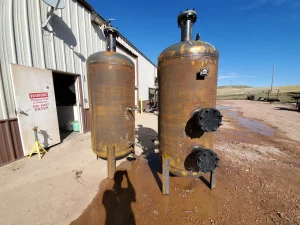
What is the primary stress of a pressure vessel?
The primary stresses in a pressure vessel arise directly from the internal or external pressure acting on the vessel. These stresses are essential in determining the structural integrity and safety of the vessel. Depending on the geometry of the vessel (cylindrical, spherical, etc.), these stresses vary. For pressure vessels, the primary stresses are usually classified into two main types:
| Hoop (Circumferential) Stress: |
| This is the stress in the circumferential direction (around the vessel). |
| In a cylindrical vessel, it is typically the highest stress and acts perpendicular to the vessel’s axis, wrapping around its circumference. |
| Mathematically, for thin-walled cylindrical pressure vessels: σhoop=tP×r Where: σhoop = Hoop stress (in Pascals or PSI) P = Internal pressure (in Pascals or PSI) r = Radius of the vessel (in meters or inches) t = Wall thickness (in meters or inches) |
| Longitudinal (Axial) Stress: |
| This stress acts along the length (or axis) of the vessel. |
| In a cylindrical vessel, it arises due to the internal or external pressure acting on the vessel’s end caps or heads. |
| Mathematically, for thin-walled cylindrical pressure vessels: σlongitudinal=2tP×r Where: σlongitudinal = Longitudinal stress (in Pascals or PSI) P, r, and t are as defined above. |
| For a spherical pressure vessel, the stress due to internal pressure is uniform in every direction (there’s no distinction between hoop and longitudinal stresses). For thin-walled spherical vessels: σ=2tP×r Where: σ = Stress in the vessel (in Pascals or PSI) P, r, and t are as defined above. |
It’s important to note that these formulas are simplified and primarily apply to thin-walled pressure vessels. Thick-walled vessels or vessels under complex loading require more sophisticated analyses, often involving numerical methods or more advanced equations from elasticity theory.
Secondary and Tertiary Stresses:
While primary stresses arise directly from the internal or external pressures, pressure vessels also experience other types of stresses.
- Secondary Stresses: These are caused by constraints on the vessel, such as temperature gradients (thermal stresses) or differential settlements in the vessel’s foundation. These stresses can cause localized distortions, but they’re generally self-limiting and won’t necessarily lead to catastrophic failure.
- Tertiary Stresses: These are residual stresses, often introduced during the manufacturing process, such as welding. They can combine with primary and secondary stresses, affecting the vessel’s overall strength and fatigue life.
Thermal Stresses:
If a pressure vessel is subjected to temperature variations (like during start-up, shutdown, or specific processing conditions), it can lead to uneven thermal expansion. This differential expansion can cause thermal stresses, which can be especially problematic at junctions or discontinuities in the vessel (like nozzles or attachments).
Factor of Safety:
When designing pressure vessels, it’s not sufficient to simply match the vessel’s strength to expected loads. A factor of safety is incorporated to account for uncertainties in material properties, load predictions, and unforeseen operating conditions. This factor ensures that the vessel has strength beyond the anticipated maximum load.
Fatigue and Cyclic Loading:
Over the vessel’s operational life, it might be subjected to repeated cycles of loading and unloading, causing the internal pressure to fluctuate. This cyclic loading can lead to fatigue failure, where the vessel material can fail at stress levels well below its yield strength due to the initiation and growth of microscopic cracks.
Corrosion and Material Degradation:
The material of the pressure vessel can degrade over time, especially if it’s subjected to corrosive substances. Corrosion can thin the vessel walls and create pits or cracks, reducing the vessel’s strength and lifespan. Protective coatings, corrosion-resistant materials, and corrosion inhibitors can help mitigate these effects.
External Loads and Attachments:
Apart from internal or external pressures, pressure vessels often have attachments like nozzles, flanges, or support brackets. These attachments can introduce localized stresses or act as stress concentrators. Additionally, external loads, such as wind, seismic forces, or the weight of accumulated snow, can influence the vessel’s stress state.
Understanding and mitigating the various stresses in a pressure vessel is crucial to ensure its safe and efficient operation. This requires a combination of rigorous design practices, quality materials, regular inspections, and preventive maintenance. As industries evolve and computational tools advance, the predictive analysis of stress and failure mechanisms in pressure vessels continues to improve, further enhancing safety standards and operational efficiency.
Related Blog Post
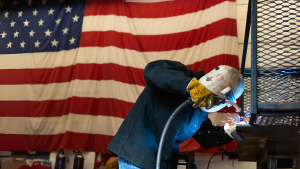
Understanding Different Types of Failure in Pressure Vessels
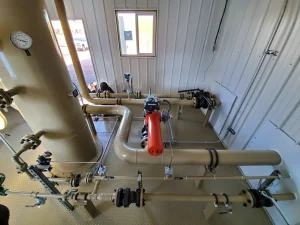
The Most Common Type of Pressure Vessel Used in Industry
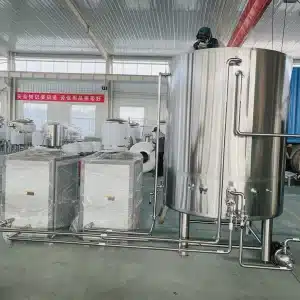
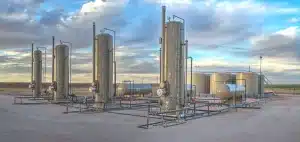
Understanding Adsorption Air Dryers
